Hello hivers it's wonderful coming on here once again to discuss an interesting and important topic. I must really say it's been a while but all thanks to passion i was able to create time to come on board. I have been discussing topics relating to mother and child and that is because am a midwife as well as nurse so it's fun to me telling us things I see daily in the course of practice which I know have been beneficial to many here.
Today I will take us through an interesting topic which I know we all as humans passed through to get to where we are now but so many do not have the idea or have not taken time to think through it or ask questions.
There is an important organ specifically in the body of a woman that forms a channel between the woman and the baby. At this juncture, some persons already know the organ am referring to while some are yet to know. Well let me go straight to the point. This important organ I will be discussing today is called the placenta.
Having Mentioned it, I would love to encourage us to patiently go through this post because I will simplify it for easy understanding, it will be interesting and you will have a lot to learn from it which might benefit you directly or people around you. So let's ride on.
THE PLACENTA.
The placenta is known as an important organ which plays an important role during the period of pregnancy for both the baby and the mother. This organ is so important that I will say there can't be pregnancy without the placenta in the picture, that's to explain how essential it is. The placenta normally is not part of the organs of the human body, it only develops immediately after fertization and implantation has taken place in the uterus. The placenta is known to have a pancake like shape and it's size varies in different individuals and situations, it's weight is usually 1/6th the babies birth weight.
PARTS OF THE PLACENTA
This organ has different parts that makes it up which helps it in carrying out it's functions. This parts are majorly divided into 3 which includes: the disc shaped placenta, the membranes and the umbilical cord
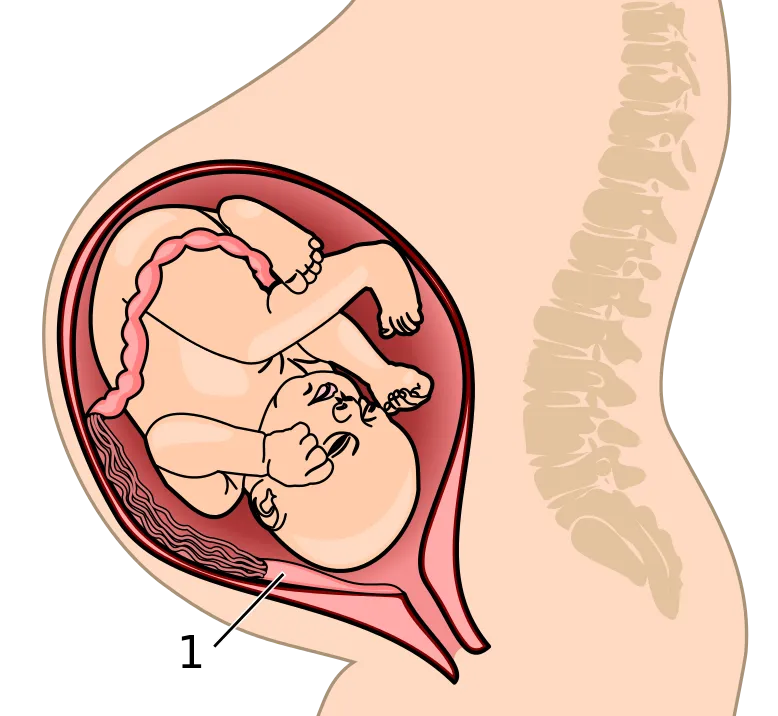
The placental system in pregnancy
The disc shaped body(placenta)
This is the major part which connects the baby to the mother. It has two parts or surfaces the maternal surface which is attached or buried directly to the wall of the uterus (endometrium) and the fetal surface which is in contact with the baby in utero.
The maternal surface is reddish in Color because of the blood from the maternal uterine surface. It also has lobes which are known as cotyledons and an average number of 16 to 20 cotyledons are found in a placenta. It is usually embedded at the upper lateral part of the uterus.
The membranes
The placenta is made up of membranes which are usually known as the chorioamniotic membrane this membrane is usually fixed to the fetal surface of the placenta and it encloses the baby in the uterus. It has two parts the amnion and the chorion.
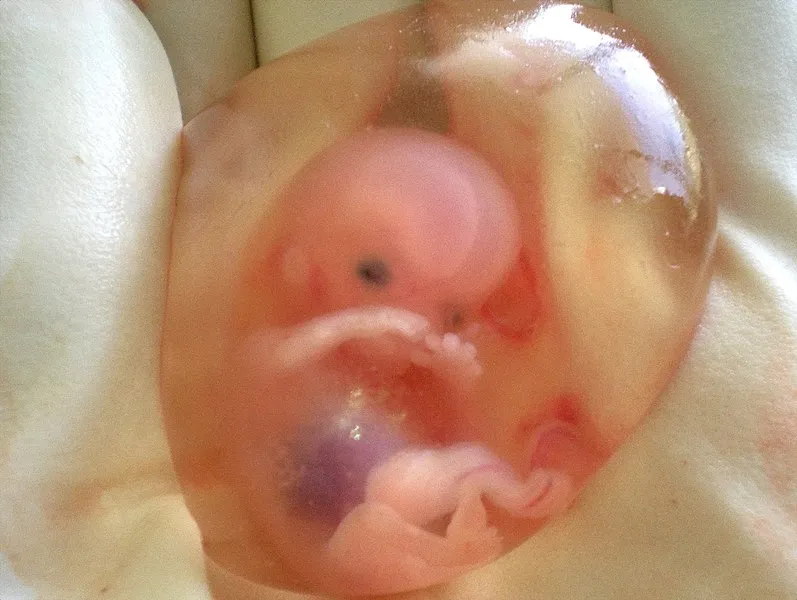
The fetus inside the amniotic sac during the first trimester of pregnancy
The amnion which is the inner most membrane, has a shiny transparent surface and is fragile in texture. It is the membrane that is in direct contact with the amniotic fluid and the baby. It has no blood supply to it, because of its fragile nature, the chorion encloses it to give it further protection. The chorion is opaque in nature and stronger than the amnion and is attached to the base of the placenta, it is whitish in color.
The umbilical cord
This is the rope like structure that directly connects or links the fetus to the mother. Usually, it is fixed to the middle part of the placenta and links to the fetus through the abdominal wall. The umbilical cord is the channel through which many processes takes place between the mother and the baby. It's average length is between 40cm to 50cm although in some cases it could be abnormally long or short.
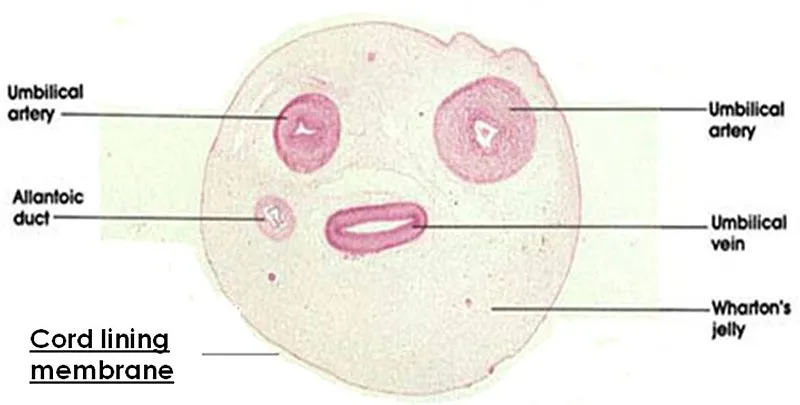
Cross section of the umbilical cord with the blood vessels
Umbilical cord can be detected on ultrasound by 6 weeks of gestation and well-visualised by 8 to 9 weeks of gestation
It encloses three blood vessels which play major roles in the function of the placenta.
These blood vessels includes: two umbilical arteries and one umbilical vein and these blood vessels are surrounded by the wharton's jelly within the umbilical cord that is gelatinous in nature and plays a major role in protecting the vessels.
The umbilical vein has the responsibility of carrying blood rich in oxygen (oxygenated blood), as well as food nutrients from the placenta to the the fetus, while the umbilical arteries carries deoxygenated blood (less oxygen) away from the fetus back to the placenta.
The blood flow through the umbilical cord is approximately 35 ml / min at 20 weeks, and 240 ml / min at 40 weeks of gestation.Adapted to the weight of the fetus, this corresponds to 115 ml / min / kg at 20 weeks and 64 ml / min / kg at 40 weeks.
Usually, these blood vessels closes after some time when the extra uterine life commences. In all these, the umbilical cord have some abnormalities that can occur in it but that will be discussed may be in my subsequent posts.
Having discussed the placenta and the onset of it's existence, I think it will also be important if I talk about the process of delivery of the placenta which is an important aspect of this topic.
PROCESS OF PLACENTA DELIVERY
Like I said earlier, am trying as much as I can to simplify this topic inorder to carry everyone along. So back to the discussion. The process of placenta delivery takes place during the third stage of labour. I know some persons will be like how many stages of labour do we have? So to further clarify us, labour being the processes involved during the childbirth, has 3 major stages comprising of uterine contraction and dilatation of the cervix to the delivery of the baby and then to the delivery of the placenta which is the third stage and according to some school of thoughts,the fourth stage being 1 hour post placenta delivery.
Procedure
• After the baby is delivered, the umbilical cord is usually clamped and cut to separate the mother and baby and this marks the beginning of the baby's extra uterine life.

Cutting of the cord after delivery
• Next oxytocin injection is administered intramuscularly on the thigh of the woman while some intravenously by adding it into an infusion of Normal saline to go in slowly and this is to help facilitate uterine contraction, prevent bleeding and aid the process of placental separation from the walls of the uterus (womb) for easy delivery to prevent postpartum bleeding in the woman.
This stage is very vital during the process of delivery because mismanagement could cost the life of the woman through bleeding.
There are various methods that can be used during the process of delivery of the placenta though two out of all are commonly used in practice especially in my country and these two are the control cord traction method and the manual methods. Both methods of placental delivery requires experience as anything can go wrong if not done properly. In the control cord traction, artery forcep is usually used in which the remaining part of the umbilical cord is rolled round it completely and gentle pulling force is applied inorder to aid the separation process and delivery of the placenta. Adequate care is also applied during the pulling process inorder for the cord not to separate from the placenta through cutting.
The manual method simply involves the use of hand in separating as well as delivering the placenta from the uterine wall and it's done through insertion of the sterile gloved hand through the vagina into the uterus. This is usually done by either a trained midwife or an obstetrician in standard conditions although most times its being practiced by traditional birth attendants (TBAs) in rural areas.
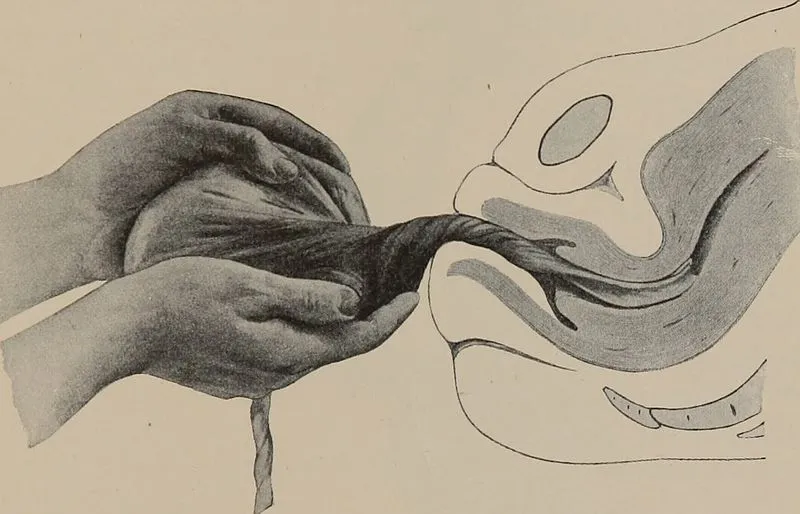
The manual method of placenta delivery
• Immediately the placenta is delivered, it is checked for completion to ensure no part of it is missen and this is usually done under running water so as to clearly see it. In addition, the uterus is further checked to ensure nothing like blood clots or remains of placenta which could cause bleeding is in it and this is done through the insertion of a gloved sterile hand into the uterus to clear it of any remains. After which the placenta is weighed.
That's all for the process of delivery of the placenta. Another important thing in this discussion is to know the the functions of this placenta during the period of pregnancy because it may not really make sense not knowing it's importance so let's continue.
WHAT ARE THE FUNCTIONS OF THE PLACENTA DURING THE PERIOD OF PREGNANCY?
This organ has numerous functions during the gestation period (pregnancy) but I will be discussing briefly only seven which are the major functions and they include :
✓ Transportation function
The placenta serves as the channel in the transportation of blood which is rich in oxygen (oxygenated blood) as well as nutrients from the mother to the baby (fetus). Without this the baby will not be able to get it's necessary nutrients for adequate growth and development in utero. In some conditions where the cords are knotted, the transport system will be altered which most times leads to the death of the baby.
✓ Excretion of waste
Waste products from the baby is usually removed and transfered to the mother through which it's gotten rid of and this is possible through the help of the placenta. Some of these waste products are carbon dioxide, urea and creatinine which are harmful to the body if not removed.
✓ Protection
The placenta plays a protective role for the baby during pregnancy because it's through it that the baby gains immunity against diseases in utero through the transfer of antibodies from the mother to the baby. Also, the placenta serves as a barrier against some substances and drugs which could be harmful to the baby that the mother consumes during this period of pregnancy and this is through the action of the placental barrier, although some harmful substances like nicotine and caffeine can pass through this Barrier which is the reason why they are discouraged during pregnancy.
✓ Endocrine function
This organ helps in the secretion of some hormones which play crucial roles during the period of pregnancy in encouraging the growth and maturation of the baby as well as the placenta and the mother as well. These hormones includes estrogen, Human placental lactogen and progesterone.
✓ Gaseous exchange
The placenta helps in the exchange of gases between the fetal and maternal circulation and some of these gases are the oxygen and carbon dioxide. The oxygen is carried to the fetus from the mother,while carbon dioxide from the fetus is carried to the mother and this is through the help of the blood vessels.
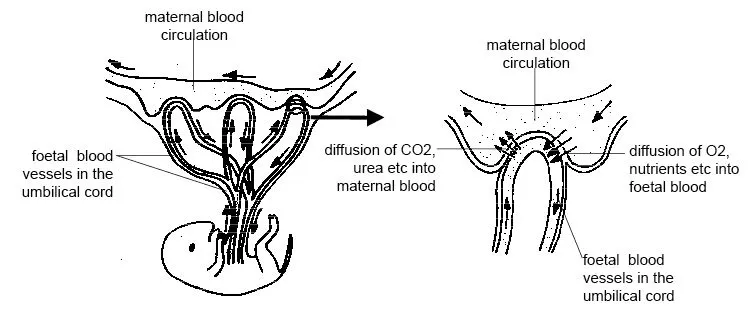
Gaseous exchange functions of the placenta
✓ Nutritional function
The placenta helps in the provision of adequate nutrition for the baby in utero like glucose,amino acids from proteins,lipids, minerals and vitamins as well as other vital nutrients that will help in the maturation and growth of the baby all through its life in the womb. The amount of nutrients available for the baby during this period of pregnancy will determine how fast and well the baby grows and develops.
✓ Storage function
The placenta helps in the storage of glucose in the form of glycogen as well as fat storage for the baby during this period till the organs develops.
Wow! I think I have really done justice to this topic atleast to a great extent and I hope we learnt something from it? I will be glad getting meaningful and encouraging supports and inputs from everyone here. Anticipate my next post which may likely be a continuation of this one, it will really be interesting as I will be discussing some abnormalities or disorders of the placenta. Thanks a lot for your time.
Reference